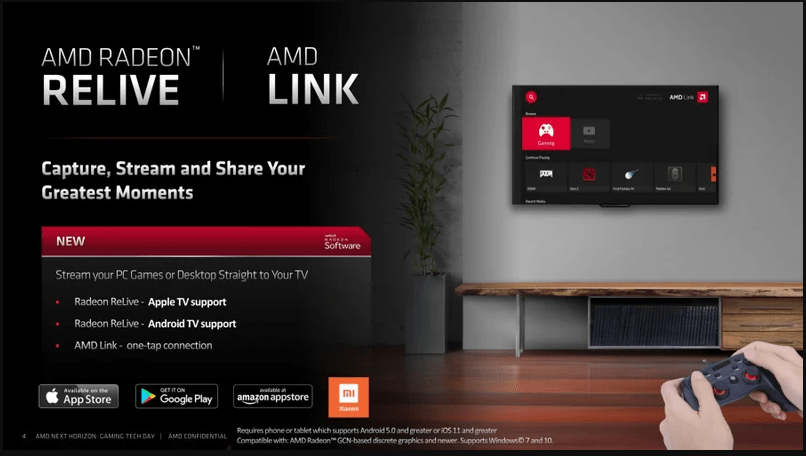The Radeon RX 5700 XT graphics card was first released by AMD on July 7, 2019. One of AMD's manufacturing partners, Taipei-based UTL, launched its PowerColor Radeon RX 5700 XT card. It is available online for approximately €450.
Card features
The RX 5700 XT is an AMD graphics card based on a brand-new architecture: RDNA. This architecture is characterized by a high-performance yet energy-efficient system (with increasingly lower power consumption). The 5000 series GPU boasts 1.5 times the performance per watt of the previous generation and 2.3 times the performance in size. Thus, the RDNA architecture offers 50% greater energy efficiency compared to the GCN architecture of the previous Radeon RX Vega. The RDNA-based Navi 10 GPU contains 10.3 billion transistors . For comparison, the Vega 64 has 12.5 billion transistors, while Nvidia's TU106 has 10.8 billion.

7-nanometer process . AMD abandoned HBM2 memory to focus on DDR6 memory. HBM2 memory offers good performance but is very expensive and difficult to manufacture. The 7nm process allowed the Navi 10 chip to be quite compact: 251 mm² instead of 495 mm² for the Vega 64. It also outperforms Nvidia's TU106 chip on 2000-series cards in terms of density, as the latter occupies 445 mm² .
The Radeon RX 5700 XT graphics card features 2,560 compute units , 64 render output units , and 160 texture units . This card consumes 225 watts. It consumes less power than the GeForce RTX 2070 Super, which requires 235 watts to operate. The minimum power supply for a PC hosting the Radeon RX 5700 XT is 600 watts.
This card features 8GB of DDR6 operating at a base clock speed of 1.605 GHz on the 256-bit memory bus. This gives the GPU a bandwidth of 448 GB/s. The GPU's integrated transistors switch at a boost clock speed of 1.905 GHz during boot clocking. With the RDNA architecture, AMD introduced a new frequency concept called the game clock. The RX 5700 XT, for its part, boasts a game clock speed of 1.755 GHz.
In terms of design, the card has a sleek and compact look. It does not feature an RGB LED system. This card measures 29.3 x 19.1 x 6.9 centimeters and weighs approximately 1.25 kg. It uses a PCIe 16x 4.0 interface, which is a new feature. Indeed, the previous generation used the PCI 3.0 standard.

The card's performance
The RX 5700 XT reaches speeds of up to 1.905 GHz , surpassing the Radeon VII, which is capped at 1.8 GHz. This 50% leap in energy efficiency is primarily due to the new 7-nanometer manufacturing process, the new RDNA architecture , and optimizations made to the Ryzen CPU. AMD has managed to produce a lower-priced graphics card thanks to the switch to GDDR6 memory. The company no longer uses GDDR5 or HBM on its next-generation memory cards.

This architecture does not yet support ray tracing: it's still too early, according to David Wang, Head of AMD's Radeon Division. However, AMD is already planning to design the RDNA2, also known as Next Gen RDNA, which will support ray tracing technology.
The new Navi 10 is able to deliver 8K HDR video at 60 FPS or 4K at 240 FPS via its DisplayPort output.
Various features allow for a high-performance system and sharper graphics rendering, including Image Sharpening, Local Streaming and Radeon Anti-Lag.
Image Sharpening is AMD's answer to Nvidia's DSLL. It's a post-processing effect that allows images to be displayed more sharply. This enables graphics rendering comparable to 4K even when the resolution used is WQHD. The result is quite surprising, with a negligible frame rate loss of less than 1.5%.

Local streaming lets you play PC games on Apple TV or Android TV Radeon Link app makes it easy to connect your PC to your TV. AMD Radeon Relieve lets you capture and relive your gaming highlights and share them with your community. Playing and sharing have never been easier.

As for Radeon Anti-Lag , it works by precisely timing the processing of incoming data to the GPU and reducing latency. This allows for more synchronous and consistent work between the CPU and GPU, thus minimizing processing wait times. Radeon Anti-Lag therefore makes the system more responsive in games.
RX 5700 XT Benchmarking
The RX 5700 XT scores 16,713 on G3DMark. This is slightly lower than the GeForce RTX 2070 SUPER, which scores 18,117, representing an 8.4% performance increase. However, the RX 5700 XT is 11.4% more powerful than the GeForce GTX 1080 (G3DMark score 14,803) and 16% more efficient than the GeForce RTX 2060 (G3DMark score 14,043).

On 3DMark, the RX 5700 XT obtains a score of 9,501. It therefore falls between the GeForce GTX 1080 (3DMark score 7,554) and the GeForce GTX 1080 Ti (3DMark score 9,941).

When testing the RX 5700 XT on Fortnite, we obtained an average frame rate of 245 FPS at 720p resolution. At 1080p high resolution, the card delivered 125 FPS. The frame rate was 77.5 FPS at QHD 1440p and 28.5 FPS at 4K resolution.

In short, the RX 5700 XT is a high-end graphics card that rivals the GeForce 2070 and GeForce 2060 Super thanks to its new RDNA architecture and various integrated software features. It's also more affordable and delivers good performance at WQHD resolution. The only downside is that this card doesn't yet support ray tracing. However, AMD's Image Sharpening feature compensates for this limitation. The RX 5700 XT is available online for around €450.





